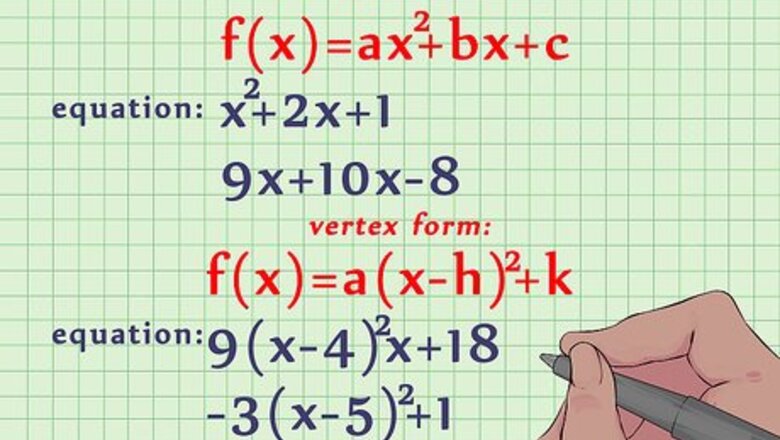
views
X
Expert Source
Jake AdamsAcademic Tutor & Test Prep Specialist
Expert Interview. 20 May 2020.
Graphing a quadratic equation is a matter of finding its vertex, direction, and, often, its x and y intercepts. In the cases of relatively simple quadratic equations, it may also be enough to plug in a range of x values and plot a curve based on the resulting points. See Step 1 below to get started.
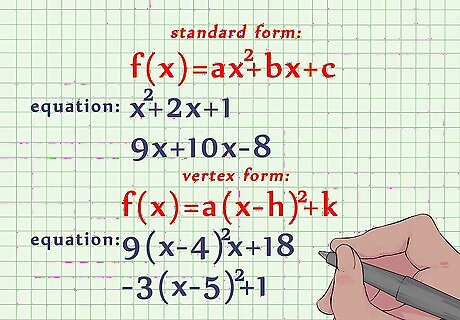
Determine which form of quadratic equation you have. The quadratic equation can be written in three different forms: the standard form, vertex form, and the quadratic form. You can use either form to graph a quadratic equation; the process for graphing each is slightly different. If you're doing a homework problem, you'll usually receive the problem in one of these two forms - in other words, you won't be able to choose, so it's best to understand both. The two forms of quadratic equation are: Standard form. In this form, the quadratic equation is written as: f(x) = ax + bx + c where a, b, and c are real numbers and a is not equal to zero. For example, two standard form quadratic equations are f(x) = x + 2x + 1 and f(x) = 9x + 10x -8. Vertex form. In this form, the quadratic equation is written as: f(x) = a(x - h) + k where a, h, and k are real numbers and a does not equal zero. Vertex form is so named because h and k directly give you the vertex (central point) of your parabola at the point (h,k). Two vertex form equations are f(x) = 9(x - 4) + 18 and -3(x - 5) + 1 To graph either of these types of equations, we need to first find the vertex of the parabola, which is the central point (h,k) at the "tip" of the curve. The coordinates of the vertex in standard form are given by: h = -b/2a and k = f(h), while in vertex form, h and k are specified in the equation.
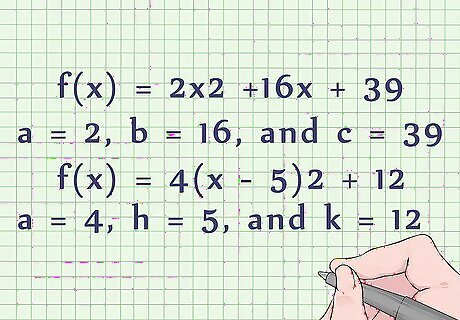
Define your variables. To be able to solve a quadratic problem, the variables a, b, and c (or a, h, and k) usually need to be defined. An average algebra problem will give you a quadratic equation with the variables filled in, usually in standard form, but sometimes in vertex form. For example, for the standard form equation f(x) = 2x +16x + 39, we have a = 2, b = 16, and c = 39. For the vertex form equation f(x) = 4(x - 5) + 12, we have a = 4, h = 5, and k = 12.
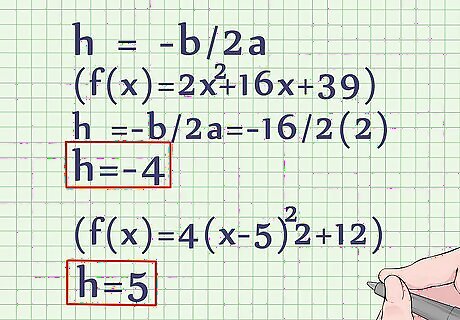
Calculate h. In vertex form equations, your value for h is already given, but in standard form equations, it must be calculated. Remember that, for standard form equations, h = -b/2a. In our standard form example (f(x) = 2x +16x + 39), h = -b/2a = -16/2(2). Solving, we find that h = -4. In our vertex form example (f(x) = 4(x - 5) + 12), we know h = 5 without doing any math.
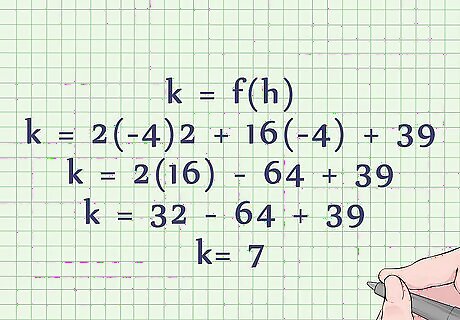
Calculate k. As with h, k is already known in vertex form equations. For standard form equations, remember that k = f(h). In other words, you can find k by replacing every instance of x in your equation with the value you just found for h. We have determined in our standard form example that h = -4. To find k, we solve our equation with our value for h replacing x: k = 2(-4) + 16(-4) + 39. k = 2(16) - 64 + 39. k = 32 - 64 + 39 = 7 In our vertex form example, again, we know the value of k (which is 12) without having to do any math.
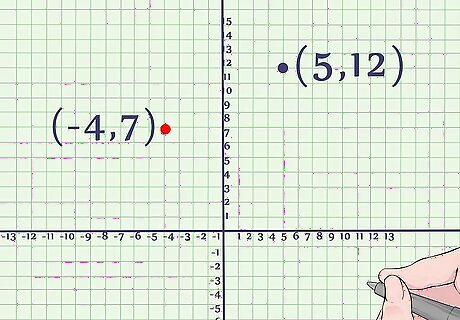
Plot your vertex. The vertex of your parabola will be the point (h, k) - h specifies the x coordinate, while k specifies the y coordinate. The vertex is the central point in your parabola - either the very bottom of a "U" or the very top of an upside-down "U." Knowing the vertex is an essential part of graphing an accurate parabola - often, in schoolwork, specifying the vertex will be a required part of a question. In our standard form example, our vertex will be at (-4,7). So, our parabola will peak 4 spaces to the left of 0 and 7 spaces above (0,0). We should plot this point on our graph, being sure to label coordinates. In our vertex form example, our vertex is at (5,12). We should plot a point 5 spaces to the right and 12 spaces above (0,0). EXPERT TIP Joseph Meyer Joseph Meyer Math Teacher Joseph Meyer is a High School Math Teacher based in Pittsburgh, Pennsylvania. He is an educator at City Charter High School, where he has been teaching for over 7 years. Joseph is also the founder of Sandbox Math, an online learning community dedicated to helping students succeed in Algebra. His site is set apart by its focus on fostering genuine comprehension through step-by-step understanding (instead of just getting the correct final answer), enabling learners to identify and overcome misunderstandings and confidently take on any test they face. He received his MA in Physics from Case Western Reserve University and his BA in Physics from Baldwin Wallace University. Joseph Meyer Joseph Meyer Math Teacher Develop strong graphing skills. Drawing graphs by hand will help you develop foundational graphing skills, especially in understanding scales and axes. This will build a strong base for you to use helpful online tools to visualize complex relationships, perform calculations, and prepare for standardized tests.
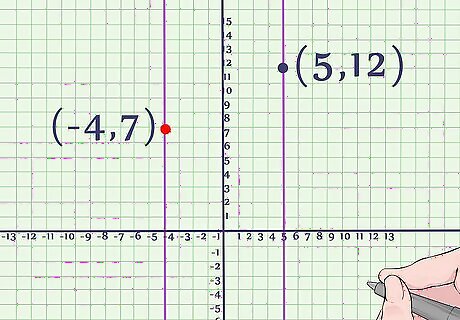
Draw the parabola's axis (optional). A parabola's axis of symmetry is the line running through its middle which divides it perfectly in half. Across this axis, the left side of the parabola will mirror the right side. For quadratics of the form ax + bx + c or a(x - h) + k, the axis is a line parallel to the y-axis (in other words, perfectly vertical) and passing through the vertex. In the case of our standard form example, the axis is a line parallel to the y-axis and passing through the point (-4, 7). Though it's not part of the parabola itself, lightly marking this line on your graph can eventually help you see how the parabola curves symmetrically.

Find the direction of opening. After having figured out the vertex and axis of the parabola, we next need to know whether the parabola opens upwards or downwards. Luckily, this is easy. If "a" is positive, the parabola will open upwards, while if "a" is negative, the parabola will open downwards (i.e., it will be turned upside-down.) For our standard form example (f(x) = 2x +16x + 39), we know we have a parabola opening upwards because, in our equation, a = 2 (positive). For our vertex form example (f(x) = 4(x - 5) + 12), we know we have also have a parabola opening upwards because a = 4 (positive).
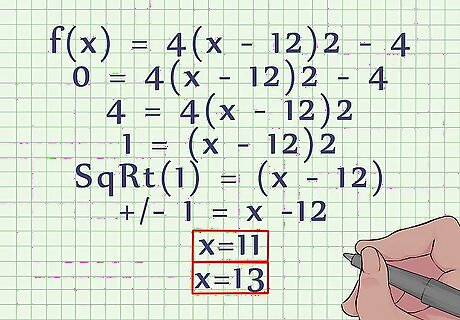
If necessary, find and plot x intercepts. Often, on schoolwork, you'll be asked to find a parabola's x-intercepts (which are either one or two points where the parabola meets the x axis). Even if you're not to find them, these two points can be invaluable for drawing an accurate parabola. However, not all parabolas have x-intercepts. If your parabola has a vertex opens upward and has a vertex above the x axis or if it opens downward and has a vertex below the x axis, it won't have any x intercepts. Otherwise, solve for your x intercepts with one of the following methods: Simply set f(x) = 0 and solve the equation. This method may work for simple quadratic equations, especially in vertex form, but will prove exceedingly difficult for more complicated ones. See below for an example f(x) = 4(x - 12) - 4 0 = 4(x - 12) - 4 4 = 4(x - 12) 1 = (x - 12) SqRt(1) = (x - 12) +/- 1 = x -12. x = 11 and 13 are the parabola's x-intercepts. Factor your equation. Some equations in the ax + bx + c form can be easily factored into the form (dx + e)(fx +g), where dx × fx = ax, (dx × g + fx × e) = bx, and e × g = c. In this case, your x intercepts are the values for x which make either term in parentheses = 0. For example: x + 2x + 1 = (x + 1)(x + 1) In this case, your only x intercept is -1 because setting x equal to -1 will make either of the factored terms in parentheses equal 0. Use the quadratic formula. If you can't easily solve for your x intercepts or factor your equation, use a special equation called the quadratic formula designed for this very purpose. If it isn't already, get your equation into the form ax + bx + c, then plug a, b, and c into the formula x = (-b +/- SqRt(b - 4ac))/2a. Note that this often gives you two answers for x, which is OK - this just means your parabola has two x intercepts. See below for an example: -5x + 1x + 10 gets plugged into the quadratic formula as follows: x = (-1 +/- SqRt(1 - 4(-5)(10)))/2(-5) x = (-1 +/- SqRt(1 + 200))/-10 x = (-1 +/- SqRt(201))/-10 x = (-1 +/- 14.18)/-10 x = (13.18/-10) and (-15.18/-10). The parabola's x intercepts are at approximately x = -1.318 and 1.518 Our previous standard form example, 2x + 16x + 39 gets plugged into the quadratic formula as follows: x = (-16 +/- SqRt(16 - 4(2)(39)))/2(2) x = (-16 +/- SqRt(256 - 312))/4 x = (-16 +/- SqRt(-56)/-10 Because finding the square root of a negative number is impossible, we know that no x intercepts exist for this particular parabola.
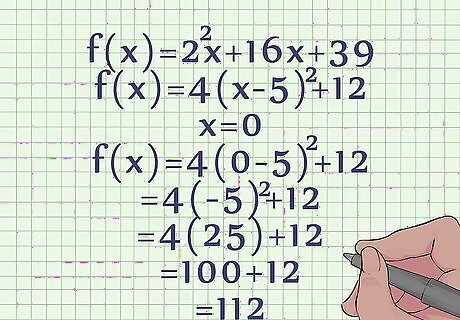
If necessary, find and plot the y intercept. Though it's often not necessary to find an equation's y intercept (the point at which the parabola passes through the y axis), you may eventually be required to, especially if you're in school. This process is fairly easy - just set x = 0, then solve your equation for f(x) or y, which gives you the y value at which your parabola passes through the y axis. Unlike x intercepts, standard parabolas can only have one y intercept. Note - for standard form equations, the y intercept is at y = c. For example, we know our quadratic equation 2x + 16x + 39 has a y intercept at y = 39, but it can also be found as follows: f(x) = 2x + 16x + 39 f(x) = 2(0) + 16(0) + 39 f(x) = 39. The parabola's y intercept is at y = 39. As noted above, the y intercept is at y = c. Our vertex form equation 4(x - 5) + 12 has a y intercept that can be found as follows: f(x) = 4(x - 5) + 12 f(x) = 4(0 - 5) + 12 f(x) = 4(-5) + 12 f(x) = 4(25) + 12 f(x) = 112. The parabola's y intercept is at y = 112.
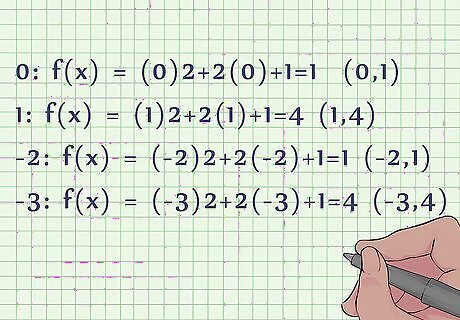
If necessary, plot additional points, then graph. You should now have a vertex, direction, x intercept(s), and, possibly, a y intercept for your equation. At this point, you can either attempt to draw your parabola using the points you have as a guideline, or you can find more points to "fill out" your parabola so that the curve you draw is more accurate. The easiest way to do this is simply to plug in a few x values on either side of your vertex, then plot these points using the y values you obtain. Often, teachers will require you to obtain a certain number of points before you draw your parabola. Let's revisit the equation x + 2x + 1. We already know its only x intercept is at x = -1. Because it only touches the x intercept at one point, we can infer that its vertex is its x intercept, which means its vertex is (-1,0). We effectively only have one point for this parabola - not nearly enough to draw a good parabola. Let's find a few more to ensure we draw an accurate graph. Let's find the y values for the following x values: 0, 1, -2, and -3. For 0: f(x) = (0) + 2(0) + 1 = 1. Our point is (0,1). For 1: f(x) = (1) + 2(1) + 1 = 4. Our point is (1,4). For -2: f(x) = (-2) + 2(-2) + 1 = 1. Our point is (-2,1). For -3: f(x) = (-3) + 2(-3) + 1 = 4. Our point is (-3,4). Plot these points to the graph and draw your U-shaped curve. Note that the parabola is perfectly symmetrical - when your points on one side of the parabola lie on whole numbers, you can usually save yourself some work by simply reflecting a given point across the parabola's axis of symmetry to find the corresponding point on the other side of the parabola.




















Comments
0 comment